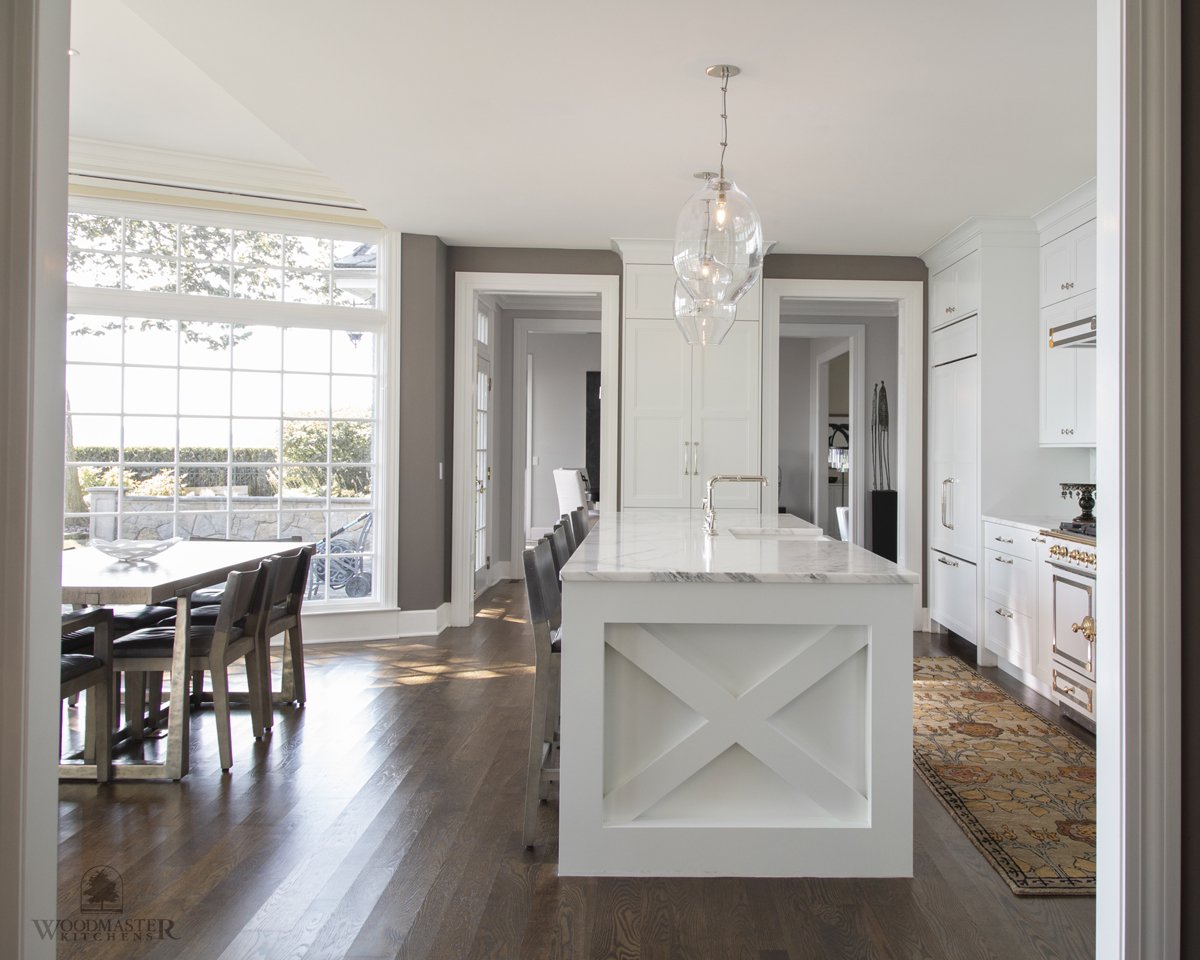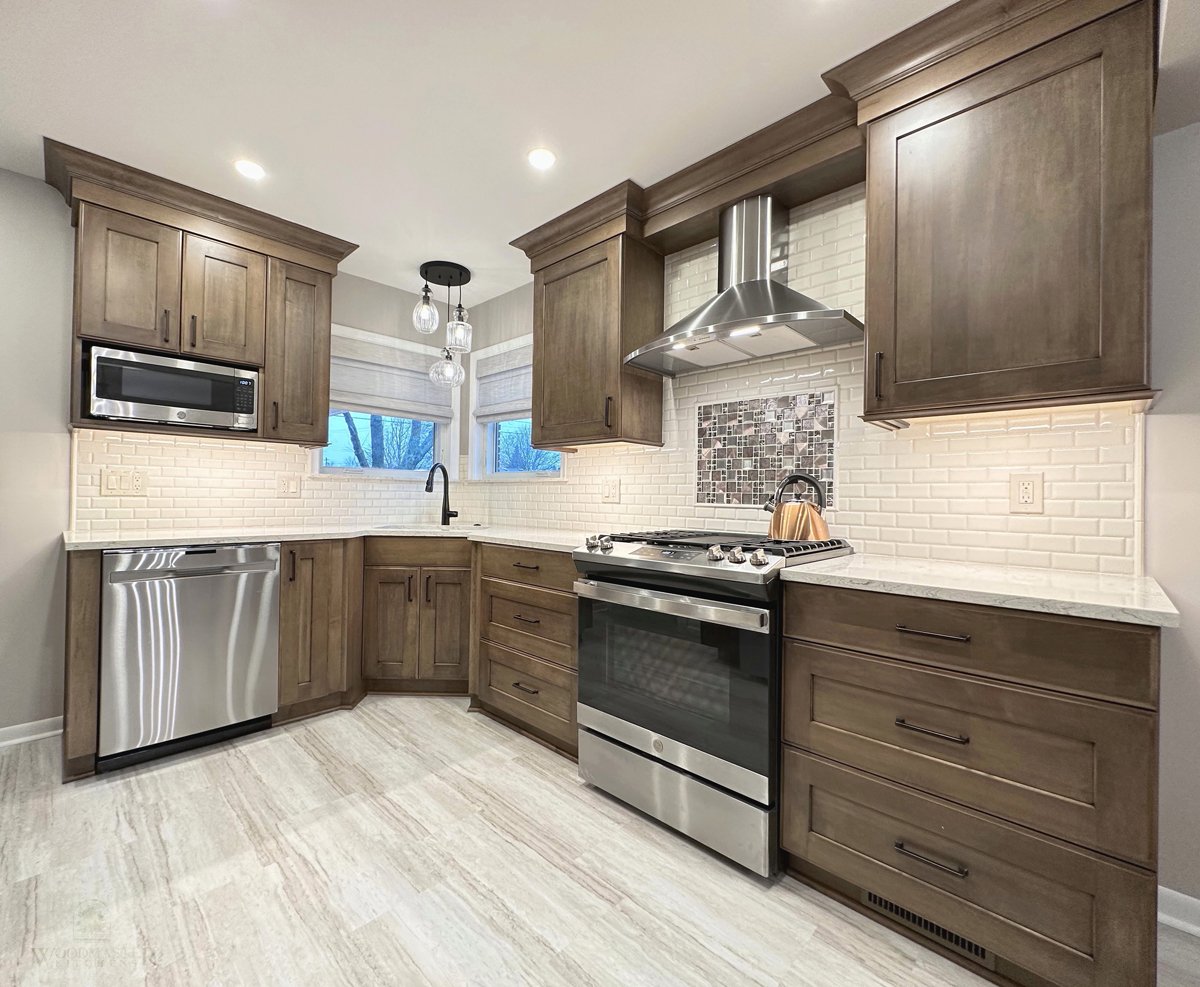Luxury Vinyl vs. Hardwood Flooring for Kitchen and Bath Design
There are so many decisions to be made when you’re undertaking a kitchen or bath remodel. In addition to selecting your design style and color scheme, you must choose products for your remodel that fit both your design aesthetic and functional needs. One of the hardest working surfaces in any busy area of your home is the floor. It must withstand foot traffic, pets, dropping heavy items, and spills and splashes (especially in bath and kitchen designs).
Hardwood floors are always popular for their timeless quality, but luxury vinyl has been growing in popularity due to the latest advances in its appearance and durability. Sometimes, when you’ve narrowed it down to these two options, it’s hard to choose which option would be best for your design. If you want wooden flooring for your kitchen or bath design, should you go for the real thing or a good imitation?
Luxury Vinyl Tile or Plank (LVT/P) used to appear obvious as a substitute for wood or tile but now it’s much harder to differentiate as the standard for producing luxury vinyl has improved. Durability, budget, and sustainability are all key factors that could influence your decision. It’s important to understand how both will perform in the area you want them in.
You could also choose both materials for different parts of an open plan first-floor design, such as hardwood in a dining area and LVP in the cooking zone of your kitchen remodel. You might want underfloor heating in a bath remodel, so hardwood might not be the best option for that. Will there potentially be much water on the floor? Is low-maintenance flooring a priority for you? Do you have pets in your home? Will there be much traffic on the floor or is it a master bath for one? Decide first what you need and what your priorities are before investigating flooring options.
We’re here to bring you up to speed on LVT/P and hardwood flooring to help you choose which option is best for your home.
What You Need to Know About Hardwood Flooring
Natural wood always brings warmth to a design and both solid and engineered hardwood are classic materials that never fail to impress. Solid hardwood embodies elegance and character but needs some preparation before it’s installed. It must be placed in the room to acclimatize for several days. This prevents the wood from contracting or expanding, depending on the temperature.
The solid wood planks are then either nailed or glued to the subfloor underneath, which is more work than LVP, but it increases their durability and longevity. Hardwood also demands more maintenance throughout its long life. It can be laid in long plank, parquet, or chevron formation, which are all timeless looks. This year’s wood flooring trends increasingly favor longer and wider planks and also putting different shades together. If you want to change up your natural wood finish you can get it distressed or hand-scraped at any time, which also makes it less slippery in moisture and spill-prone rooms.
Engineered hardwood is slightly more budget friendly as it is a layer of hardwood placed on top of wood by-products. It can still be distressed or finished just like solid hardwood. Engineered hardwood won’t warp so is a good option to place over underfloor heating or to install in a wider format. It’s also cheaper to install as it simply clicks together and floats on the subfloor.
What You Need to Know About LVP/LVT
Luxury Vinyl Plank or Tile is a durable flooring material that works well in a busy space. It has several layers of backing material compressed together to form a base of desired rigidity. After being heat-treated for extra strength, a photograph film layer with authentic textures is placed on top. This can look and feel like wood grain and knots or have the bumps and veins of natural stone. A final wear layer ensures maximum durability and longevity of the product. Current production techniques mean that LVP/T is also being manufactured to meet demands for sustainability.
LVP/T has been thoughtfully designed and fabricated so is much more stylish and durable than cheaper vinyl or laminate products. It is very straightforward to lay, as it can be clicked together or glued onto the subfloor. Despite looking like hardwood or natural stone, it feels warmer and softer underfoot. There is a stain and scratch protector integrated into the wear layer and it also boasts water resistance. For this reason, it’s very easy to maintain and will withstand all cleaning products.
Decide How Much Maintenance You’re Prepared For
Are pets a part of your family? Unfortunately, claws can scratch the surface of a hardwood floor.
Moving furniture around also leaves permanent scratches and scrapes, so consider this fact around a dining table or island with seating. If these marks and dents don’t appeal to you, they can be remedied by having the hardwood surface sanded and resurfaced professionally. For some people, the natural wear and tear of hardwood is part of its charm, so decide what is important to you before selecting your preferred flooring.
There is potential for water splashing onto the floor in both kitchen and bath designs. If hardwood flooring gets wet, it must be cleaned and dried immediately. You also need to regularly wax the surface of a high-shine wooden floor. Hardwood floors last longer than LVP and their lifespan can be extended through refinishing, but not without effort on the homeowner’s part to properly clean and maintain the surface.
LVP can be swept, vacuumed, and mopped regularly and pet and human activity generally don’t damage its surface. The protective polyurethane wear layer ensures less daily maintenance is required for LVP/T, but it won’t outlive hardwood flooring. Ensuring the integrity of a hardwood floor’s appearance is a constant commitment, but if you’re willing to invest, it pays off for years to come.
Figure Out What Suits Your Style
The aesthetic of the flooring you choose is hugely important to your kitchen or bath design. You can’t choose something based purely on functionality. It should also represent your style and be something you enjoy living with, especially in such visible areas of your home as the kitchen design and living areas.
Also, consider whether you want it to be a backdrop to your remodel or play a more central role as a design statement. If you want very long planks, then hardwood beats LVP. The latter does have the advantage of being able to repeat a pattern though if you want your flooring style to be more uniform and predictable.
A more budget-friendly option for hardwood is to get different shades of distressed timber to form parquet flooring, resulting in a modern classic. Another current trend is for lighter shades of wood, which looks beautiful but needs constant maintenance in a high-traffic area. LVP gives you the same look but allows you to clean it much more easily. Luxury vinyl flooring comes in so many other looks that could achieve any style you want in a durable and easy to maintain surface. Natural stone, slate, or quartz-look LVT flooring can be functional and stylish for your kitchen or bath remodel.
Functionality Has to Play a Part
Function is of equal importance as form in kitchen and bath design. The flooring you choose needs to be durable to perform and last in these busy parts of your home. Engineered hardwood is often reinforced with a protective coating before it leaves the factory, making it very durable and a material that will also hold its strong shape.
LVP holds its shape due to having so many layers that have been heat treated. Since it is a synthetic material, LVP can resist a change in room temperature, surface scratches, and water damage. Consider how your household operates and choose a material that fits your needs.
LVP with a wood polymer core is more pliable than stone polymer, so it is softer underfoot.
A stone polymer core is slightly harder but can withstand more punishment.
Solid wood can warp, swell, or crack if affected by heat or water. It can also stain, so be wary of this in a food prep area.
Hardwood is durable, but you’ll need to embrace any surface damage as part of its character.
Take Sustainability into Account
LVT/P flooring is becoming increasingly sustainably produced. How can you ensure that you are getting an eco-friendly product? Check that the materials used in its layering process are recycled. An LVP component such as salt is available in abundance, so, therefore, is a sustainable choice. The finished product should also be able to be recycled. Engineered hardwood is already a recycled material, using wood by-products in its sub-layers. Solid hardwood can easily be recycled but make sure that the wood is coming from a forest that is being replanted. Tree farms provide a supply of wood that is part of a plant-harvest cycle to avoid deforestation. Research sustainable options and ask your kitchen or bath design expert to prioritize environmentally friendly products and manufacturing methods.
Consider Your Budget
Decide how much of your remodeling budget you want to set aside for your flooring. Neither hardwood nor LVP is cheap and both are considerable investments in your home. Flooring is a very important part of a kitchen or bath design as it needs to be highly durable as well as stylish.
Hardwood flooring is marginally more expensive than LVP. This takes into account the fact that trees are harvested and transported to be milled and then finished by the manufacturer. Installation costs for solid wood flooring are also more than LVP as they need to be acclimatized in situ for a while and then glued or nailed professionally.
LVP/T is made in one location and the planks can just be clicked together when installing them. There is a chance that Volatile Organic Compounds (VOCs) can be released from LVP/T but if you invest in a quality product you are dramatically reducing this risk. It’s also a good idea to go for a high-end vinyl if you are laying it over existing tiles to prevent grout lines from showing through.
Choosing the perfect flooring for your kitchen or bath remodel means assessing your budget and lifestyle. Consider how each would contribute to your style and ensure that your preferred choice won’t compromise on functionality. Discuss flooring options when you meet your design experts as part of your overall kitchen and bath design plans. Our experienced designers can help you make your decision and work with you on any aspect of your kitchen or bath remodeling needs.






